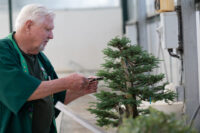
This disaster kit contains canned goods, non-perishable food, a first aid kit, batteries and more.
Ryan lely/Sonoma Valley Sun
Linda Kelly, a city manager with first hand disaster experience, spoke to the City Council Wednesday night to alert them to the need for stepped up planning. In an interview prior to the meeting, she said, “I’ve spent the last weeks meeting with staff and assessing what we have in terms of disaster preparedness, plans, staff training, emergency operations center, equipment and community awareness efforts and I’ve come to the conclusion that we are not as prepared as we need to be.”
Three days into the 2006 flood that inundated the town of Fairfax, Kelly took over as Fairfax City Manager, and the experience opened her eyes to the fact that in a serious disaster, everyone, in one way or another, is affected. Her review of Sonoma’s disaster plan was one of the first items on her agenda when she came here. “What I’ve tried to do in my staff report is outline what we’ve started to do already, what we need to do.”
Everything that needs to be done shares one bottom line: response time. “We need to equip our emergency operations center so we can be ready at a moment’s notice,” she said. “The renovated police department would be where we would set up the emergency operations team. That would be me, the police chief and department heads and designated staff. All of us would operate from there.” In a moment’s notice, they would have to have in place phones, computers and generators to keep all running. “We’ll need our forms, our check lists, our procedures, our phone lists and emergency numbers,” she said. “There are a lot of little things, like getting department heads’ home phones, and emergency numbers.” The county has a telephone emergency notification service (TENS) that can notify areas, within an hour or so.
In her report, she reviewed what disasters are actually listed on the Local Hazard Mitigation Plan, a document the Federal Emergency Management Agency (FEMA) requires every city to have. On this document, the list of possible local hazards includes earthquakes, shaking, liquifaction, landslides, wildfires, and drought. Of these, Kelly said the city is particularly concerned with wildfires.
Flooding was identified but not as a significant hazard. “There are 19 city acres in the 100-year flood plain,” she said, “and 254 acres in other flood-prone areas.” With the coming climate change, Kelly noted, heat emergencies are also something to prepare for, as is the threat of world-wide pandemic flu outbreaks.
“So in the local hazard mitigation plan, it says we are not trying to create a disaster proof region,” she said, “but a ‘disaster resistant’ one.” To get to readiness, she said the city needs more staff training, and she suggests reinstating our “disaster council,” which would be a group chaired by the mayor, and with the city manager as the director of emergency services. On the council might be the Red Cross, representatives from the county office of emergency services, the medical reserve corps, the school district, and the hospital.
The importance of establishing relationships before disaster strikes is that in any disaster, it’s not going to affect just one segment of the community. “If it’s a major disaster, it’s going to affect all. If we can set up communication mechanisms in advance,” said Kelly, ”and relationships in advance, so that when there is a disaster, we know who to contact, we know who the point persons are going to be with each of these agencies, we can share resources, if we have a need. If people are displaced, we need to set up memoranda of understanding in advance, with the Red Cross, to set up shelters.
“A lot of it is community awareness,” she said, “reminding people to get your 72-hour disaster kit. I now have a kit in my car. We’d rather have the equipment and supplies available and not have to use it.”




